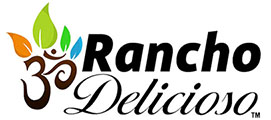How to Make Soil for Growing Plants – Part 1
Part 1: Soil Making Ingredients
Many of the “farms” in our part of Costa Rica have had cattle on them for decades, and as a result, the soil is highly degraded. Years of heavy trampling and loosening of the topsoil during rainy season has made most of it wash down into the rivers and out into the ocean.
Our tests of the topsoil at Rancho Delicioso, have shown us that the 1-2 inch-deep layer that we have left is very high quality, not seeming to be missing any crucial minerals, but there’s just not enough of it to build the deep, easily-draining raised garden beds you need to grow vegetables here.
We experimented with buying soil locally and were ripped off twice. The beautiful black earth that was delivered to us looked great at first, but turned out to be nearly pure clay, and hardened into a solid mass that plants roots couldn’t easily penetrate, after a couple months of use. We learned the hard way that good soil for growing should not clump together like clay when you harden it into a ball.
We also purchased soil by truckload that was brought all the way from the Central Valley. That worked well, but not as well as our final solution: making our own soil from scratch
How to Make the Ultimate Dirt
Here’s the list of ingredients we use, where we get them, why they’re important, etc. Some of these are optional. Nature likes to make dirt out of just about anything organic, but if you want the best possible, nutritious soil for growing veggies, then put in as many as possible. This list is long, so I don’t want to scare you away from trying this by making it seem too complicated. This is easy and you can throw a lot of stuff together to make soil and it will probably work.
 Lots and lots of grass – Sacate
Lots and lots of grass – Sacate
This is the main ingredient, perhaps 70% of it by weight. We let our grass grow in parts of our farm until it’s 1-2 meters high, then cut it with a moto-guarana (weed wacker), rake it into piles, and then transport it to a central location near where it will be used. You can also choose to just rake it into large piles and make the soil there, by bringing the rest of the ingredients to the same spot.
 Leaves and Plant material (Hojas y matas)
Leaves and Plant material (Hojas y matas)
10%: Leaves, small sticks, anything you can find growing around your place. Don’t put any madera negro or hardwoods that tend to be resistant to decomposition. Also, try to avoid putting seeds of weeds and other plants in there too, because they may end up growing in your soil and competing with your vegetables.
 Kitchen Scraps, Egg Shells, Etc – (Basura Organica)
Kitchen Scraps, Egg Shells, Etc – (Basura Organica)
2-3%: Almost any kind of food scraps will work, but avoid foods with anti-bacterial and anti-fungal properties such as garlic, onions, and all citrus. These will work, but will slow down the process. Fish bones, chicken bones, dairy products, etc are sort of frowned upon by some when making compost, but given enough time, they all break down into the soil during this process, so it’s up to you if you want to add them.
 Bags and bags of Cow Manure – raw or cured (Buñiga)
Bags and bags of Cow Manure – raw or cured (Buñiga)
5-10%: Important for nitrogen. Many local farmers will let you collect it from their farms, or you can buy sacks of it from various places in Delicias or Cobano. In quantity, at this time it’s 2000 colones ($4) per large sack, delivered to us. This is a very important ingredient. If we didn’t have all those hamburger-eaters out there creating a demand for cows, there wouldn’t be enough manure for us. But then, our soil wouldn’t have been wrecked in the first place by them.
 Bags of Chicken Manure (Gallinasa)
Bags of Chicken Manure (Gallinasa)
5%: Even more intense for nitrogen than cow manure, chicken manure can be found in Paquera. Sometimes it’s even a bit more cured if it’s been sitting around for a while. The older, the better. We get ours from a friend’s farm in Vainilla. Or best of all, if you have your own chickens, now you know what to do with their poop.
 Rice Hulls – (Granza / Cáscaras de arroz)
Rice Hulls – (Granza / Cáscaras de arroz)
5-10%: The rice hulls really help make the soil more light/fluffy, plus they add many minerals. When the soil is ready, you will still see many of these in the soil since they will not have broken down as much as the other materials, because they’re so hard. You can find rice hulls wherever there are machines that are splitting the rice. Esperanza, behind Cobano has a guy doing this, and there are some in Paquera too. We get ours delivered by huge truckload from the mainland. There, huge rice-processing plants bag the rice and sell it to cement-makers who burn it to cook the cement as part of the process to make it. This ingredient is very helpful to keep the dirt from compacting together into a solid mass later.
 Charcoal (Carbon)
Charcoal (Carbon)
2-3%: Have a bonfire and burn whatever wood you can find (as long as it isn’t infused with toxic chemicals such as treated pine or plywood. Ideally, you can you a Biochar machine, which burns the wood without releasing much carbon into the atmosphere. We have a small one at the farm, and need to build a larger one.
 Calcium (Cal)
Calcium (Cal)
A few cups of powdered calcium, which is needed by plants, and can help prevent some types of fungus. We aren’t really sure this is necessary, but it’s been recommended and doesn’t seem to hurt. You can buy this at the cooperativa. Some online gardening experts recommend caution when adding calcium in this way sine it can affect the soil’s pH.
 Bacteria – (EM / Microorganismos Effectivos)
Bacteria – (EM / Microorganismos Effectivos)
We spray the mix with a bacteria that helps to decompose the organic material in the pile. Some people use EM “Environmental Microbes” from the cooperativa. You can also get a bacteria from La Hoja Nueva, which is what we use. This helps speed up the process, but you can do without it. Bacteria are already in your soil that can do the job, only in lower quantities and they work more slowly.
 Trichoderma Asperellum Fungus – (Hongos Trichoderma)
Trichoderma Asperellum Fungus – (Hongos Trichoderma)
We buy this from La Hoja Nueva. It comes in a bag and it’s kept in the refrigerator. We take it out, mix it into water in a small quantity, and then spray it on the dirt pile. This Trichoderma Asperellum Fungus (Hongos Trichoderma) is a great ingredient for humid areas like ours. It helps to prevent other types of fungus that attack plants. There are also fungi that help plants to absorb nutrients in the soil. This ingredient isn’t needed during the dirt-making process, but it’s great to have in your dirt. You can spray it on afterwards if you prefer.
 Boron – (Boro)
Boron – (Boro)
The element Boron is very important to plants, and when we tested the soil chemically, this unfortunately wasn’t one of the elements they tested for. We noticed some leaf-curling in some of our vegetables such as amaranth and okra, and a visiting organic farming expert suggested we add a bit of boron just in case. You can order this from La Hoja Nueva by the gallon.
Dirt from Your Site – (Su Tierra)
Whatever soil you have, even if it has a lot of clay or sand, you can mix in too, plus any dirt clumps leftover from the last batch that didn’t pass through your sifting screens. Keep them in play and eventually they’ll break down into small pieces.
 Lots and lots of grass – Sacate
Lots and lots of grass – Sacate
This is the main ingredient, perhaps 70% of it by weight. We let our grass grow in parts of our farm until it’s 1-2 meters high, then cut it with a moto-guarana (weed wacker), rake it into piles, and then transport it to a central location near where it will be used. You can also choose to just rake it into large piles and make the soil there, by bringing the rest of the ingredients to the same spot.
 Leaves and Plant material (Hojas y matas)
Leaves and Plant material (Hojas y matas)
10%: Leaves, small sticks, anything you can find growing around your place. Don’t put any madera negro or hardwoods that tend to be resistant to decomposition. Also, try to avoid putting seeds of weeds and other plants in there too, because they may end up growing in your soil and competing with your vegetables.
 Kitchen Scraps, Egg Shells, Etc – (Basura Organica)
Kitchen Scraps, Egg Shells, Etc – (Basura Organica)
2-3%: Almost any kind of food scraps will work, but avoid foods with anti-bacterial and anti-fungal properties such as garlic, onions, and all citrus. These will work, but will slow down the process. Fish bones, chicken bones, dairy products, etc are sort of frowned upon by some when making compost, but given enough time, they all break down into the soil during this process, so it’s up to you if you want to add them.
 Bags and bags of Cow Manure – raw or cured (Buñiga)
Bags and bags of Cow Manure – raw or cured (Buñiga)
5-10%: Important for nitrogen. Many local farmers will let you collect it from their farms, or you can buy sacks of it from various places in Delicias or Cobano. In quantity, at this time it’s 2000 colones ($4) per large sack, delivered to us. This is a very important ingredient. If we didn’t have all those hamburger-eaters out there creating a demand for cows, there wouldn’t be enough manure for us. But then, our soil wouldn’t have been wrecked in the first place by them.
 Bags of Chicken Manure (Gallinasa)
Bags of Chicken Manure (Gallinasa)
5%: Even more intense for nitrogen than cow manure, chicken manure can be found in Paquera. Sometimes it’s even a bit more cured if it’s been sitting around for a while. The older, the better. We get ours from a friend’s farm in Vainilla. Or best of all, if you have your own chickens, now you know what to do with their poop.
 Rice Hulls – (Granza / Cáscaras de arroz)
Rice Hulls – (Granza / Cáscaras de arroz)
5-10%: The rice hulls really help make the soil more light/fluffy, plus they add many minerals. When the soil is ready, you will still see many of these in the soil since they will not have broken down as much as the other materials, because they’re so hard. You can find rice hulls wherever there are machines that are splitting the rice. Esperanza, behind Cobano has a guy doing this, and there are some in Paquera too. We get ours delivered by huge truckload from the mainland. There, huge rice-processing plants bag the rice and sell it to cement-makers who burn it to cook the cement as part of the process to make it. This ingredient is very helpful to keep the dirt from compacting together into a solid mass later.
 Charcoal (Carbon)
Charcoal (Carbon)
2-3%: Have a bonfire and burn whatever wood you can find (as long as it isn’t infused with toxic chemicals such as treated pine or plywood. Ideally, you can you a Biochar machine, which burns the wood without releasing much carbon into the atmosphere. We have a small one at the farm, and need to build a larger one.
 Calcium (Cal)
Calcium (Cal)
A few cups of powdered calcium, which is needed by plants, and can help prevent some types of fungus. We aren’t really sure this is necessary, but it’s been recommended and doesn’t seem to hurt. You can buy this at the cooperativa. Some online gardening experts recommend caution when adding calcium in this way sine it can affect the soil’s pH.
 Bacteria – (EM / Microorganismos Effectivos)
Bacteria – (EM / Microorganismos Effectivos)
We spray the mix with a bacteria that helps to decompose the organic material in the pile. Some people use EM “Environmental Microbes” from the cooperativa. You can also get a bacteria from La Hoja Nueva, which is what we use. This helps speed up the process, but you can do without it. Bacteria are already in your soil that can do the job, only in lower quantities and they work more slowly.
 Trichoderma Asperellum Fungus – (Hongos Trichoderma)
Trichoderma Asperellum Fungus – (Hongos Trichoderma)
We buy this from La Hoja Nueva. It comes in a bag and it’s kept in the refrigerator. We take it out, mix it into water in a small quantity, and then spray it on the dirt pile. This Trichoderma Asperellum Fungus (Hongos Trichoderma) is a great ingredient for humid areas like ours. It helps to prevent other types of fungus that attack plants. There are also fungi that help plants to absorb nutrients in the soil. This ingredient isn’t needed during the dirt-making process, but it’s great to have in your dirt. You can spray it on afterwards if you prefer.
 Boron – (Boro)
Boron – (Boro)
The element Boron is very important to plants, and when we tested the soil chemically, this unfortunately wasn’t one of the elements they tested for. We noticed some leaf-curling in some of our vegetables such as amaranth and okra, and a visiting organic farming expert suggested we add a bit of boron just in case. You can order this from La Hoja Nueva by the gallon.
Dirt from Your Site – (Su Tierra)
Whatever soil you have, even if it has a lot of clay or sand, you can mix in too, plus any dirt clumps leftover from the last batch that didn’t pass through your sifting screens. Keep them in play and eventually they’ll break down into small pieces.
Remember, you don’t really NEED all of these. It doesn’t have to be so complicated! We put all this in there because we are crazy about dirt and want to make it the best we possibly can.
As long as you have a big pile of grass and kitchen scraps, you can throw them in a pile and they’re probably going to make a pretty good dirt over time.
Now, on to Part 2, where we’ll show you more about the process:
How to Make Soil for Growing Plants – Part 2















